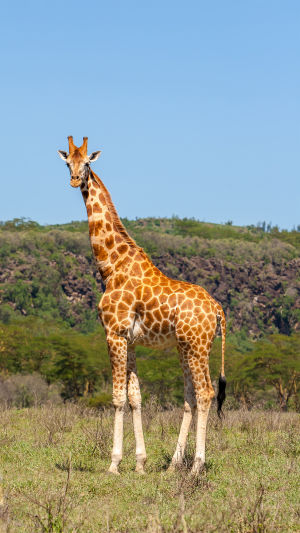There is a dry joke tells like this: Q: What is the first danger after the baby giraffe is born? A: Fell to death when it was born... Is that really true? Why haven't giraffes evolved to be safer?
Giraffes spend most of their lives standing, including sleeping. Giraffes only need 5 to 30 minutes of sleep in a 24-hour period, and they can solve their sleep problems only by taking naps, which last only a minute or two at a time, making them one of the shortest sleepers of all mammals. So it's the same when giving birth, the female giraffe gives birth standing up and the baby giraffe falls from the air and then stumbles and tries to get up.
The mother giraffe will always encourage the baby to stand up (but she can't lick the baby due to being too tall). People used to think that giraffes were "mute", but this is now known to be incorrect, because giraffes still occasionally roar, snort, and hiss, but vocalization is difficult for them because their necks are so long. The real communication between them is beyond the range of human hearing, you can pretend they are whispering.
These baby giraffes can stand up about 30 minutes after birth, but they are not stable enough. After just a few hours, they will be able to run with their mother on the savannah, and within a week they will start foraging on their own. Of course, they only eat plants, giraffes have very tough tongues and lips, specially adapted to allow them to forage in trees where other animals can't reach, eat most of the day and can eat up to 45kg of leaves and twigs per day! Their "menu" includes over 100 different varieties of leaves, roots, flowers, and pods, which means they have the most varied diet of any herbivore, though their favorite food is the acacia.
Giraffes have 32 teeth, the same number as humans. However, their mouths are very different from ours, with teeth located in the front of the lower jaw, but only in the back of the upper jaw. There is a hard plate or tooth pad at the top of the mouth that helps them grab leaves. They use their long necks to reach leaves and buds in the treetops, and their long tongues (up to 53 cm!) help them pull down leaves that grow taller. And male and female giraffes will stand on both sides of the tree to eat separately.
However, being attacked by lions, spotted hyenas, leopards and African wild dogs is more likely than being killed by a fall. Despite being protected by their mothers, many babies are killed during the giraffe's newborn season, especially when they are extremely vulnerable to hyenas. Ferocious hyenas hunt in packs because, due to the size of giraffes, they cannot face large numbers of enemies.
The only animals in the savanna that have a chance to hunt adult giraffes are lions. The giraffe's neck cannot reach the ground, and it has to awkwardly spread its front legs or kneel to reach the ground to drink. When giraffes are drinking in watering holes, they are most vulnerable because their necks are on the lower ground, which makes it difficult for giraffes to get up quickly and run away when being attacked.
But don't underestimate the "combat power" of adult giraffes, they won't be afraid even in the face of lions! A quick kick of an adult giraffe's long legs can seriously injure or even kill an unfortunate lion. A lion alone must be very brave to deal with a giraffe, and even a few lions do not dare to attack rashly.
The main driver of giraffe evolution was the change from expansive forests to more open habitats. Over the long history of the earth, the lush tropical vegetation of the African savannah gradually disappeared and was replaced by arid vegetation, and dry savannahs appeared in eastern and northern Africa and the Arabian Peninsula. According to some studies, this new habitat, combined with a different diet, including gum arabic, may have poisoned the giraffe's ancestors, and these toxins led to higher mutation rates and faster evolution rates. So, the giraffe appeared.





